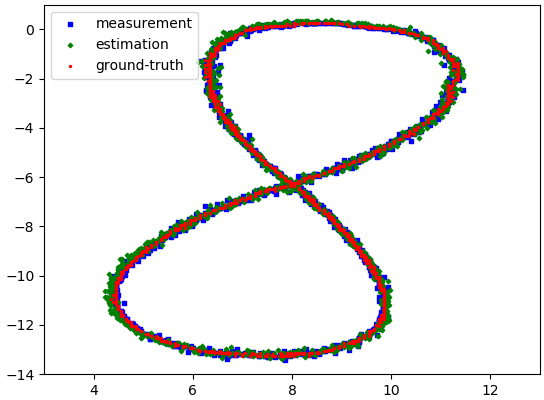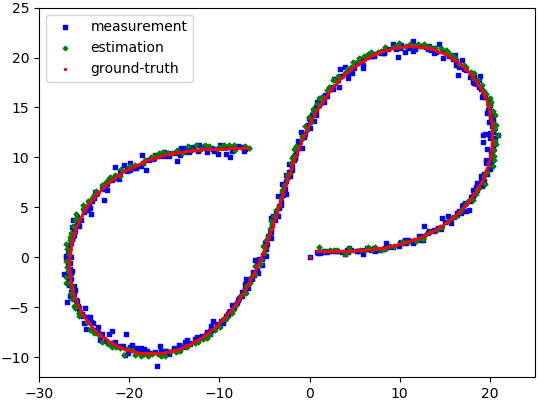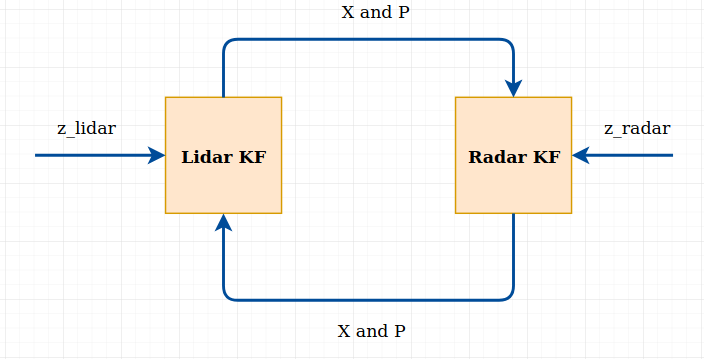This project implement extended and extended kalman filters. The test data comes from chapter of sensor fusion of the Self-Driving Car Engineer Nanodegree from Udacity.
- Clone this project
git clone https://github.com/huuanhhuynguyen/kalman_filters.git - Clone matplotlib-cpp library
git clone https://github.com/lava/matplotlib-cpp.git - Install dependencies
sudo apt-get install python-matplotlib python-numpy
Note: See https://github.com/lava/matplotlib-cpp for further instructions on installation of matplotlib-cpp.
- Make a build directory:
mkdir build && cd build - Compile:
cmake .. && make - Run it:
./kalman_filters_cppwill show the result of EKF fusion on one data example.
Change the following lines in src/main.cpp to run with another data example
or with UKF:
// App Configuration
Data data = Data::THREE; // or Data::ONE, Data::TWO
FilterType type = FilterType::EXTENDED; // or FilterType::UNSCENTED
Radar and Lidar measurements as well as ground-truth data are stored as text files
in the project folder data/). To fuse the measurements in to final estimations,
(Extended / Unscented) Kalman Filters are used.
- EKF runs separately on Lidar or Radar measurement
- Fusion of two EKFs
- UKF runs separately on Lidar or Radar measurement
- Fusion of two UKFs
Lidar KF and Radar KF process the Lidar and Radar measurement, respectively.
To fuse the estimation, the state X and covariance matrix P are shared between two filters. It is also possible to share the process uncertainty Q in addition to X and P.
Further details
### System Model
I simply use a constant acceleration model for the KFs.
[x1 ] [1 T 0 0] [x ]
[vx1] = [0 1 0 0] * [vx]
[y1 ] [0 0 1 T] [y ]
[vy1] [0 0 0 1] [vy]
But any other model that supports the interface in \include\model\model.h can be used.
It is possible to use only linear KFs for fusing the measurements. In that case, the state X = [x, y, vx, vy] and the measurement for both sensor z = [x, y].
For it, just extract the position measurement from each sensor.
To make use of velocity measurement from Radar, an EKF is needed because the measurement equation of Radar is non-linear:
rho = x*x + y*y
phi = atan2(y, x)
phi_dot = (x*vx + y*vy) / (x*x + y*y)
A linear KF is still used for processing Lidar. Indeed, linear KF is a special case
of EKF where the process and measurement functions f(X) and h(X) are linear.
Result:
| 1.txt | 2.txt | 3.txt |
|---|---|---|
 |
 |
 |
Without fusion, each UKF performs similarly as each EKF.
| 1.txt | 2.txt | 3.txt | |
|---|---|---|---|
| LidarUKF |  |
 |
 |
| RadarUKF |  |
 |
 |
However, when I fuse Lidar UKF with Radar UKF using the fusion model above. The system fails and the estimation diverges. This problem is still unsolved.
In my opinion, the reason is that UKF demands a more accurate model than EKF, while the current constant acceleration model is not sufficiently good (this is indicated by a relatively large process uncertainty matrix Q). This model doesn't have any knowledge of the vehicle dynamics (i.e. the car is considered as a single moving point). Unfortunately, I don't have the dynamics infomation of the vehicle in the data to construct a better model.
The problem of UKF is also addressed here:
Abstract: The Unscented Kalman filter (UKF) may suffer from performance degradation and even divergence while mismatch between the noise distribution assumed as a priori by users and the actual ones in a real nonlinear system.
